Our Spell Druid deck list guide goes through the ins-and-outs of this powerful Druid build for the Ashes of Outland expansion! This guide will teach you how to mulligan, pilot, and substitute cards for this archetype!
Introduction to Spell Druid
Ashes of Outland is out, but one particular card already made waves before the release of Hearthstone’s newest expansion: Kael'thas Sunstrider. Similar to Marin the Fox, Team 5 made the Prince of Quel’thalas available to all players one week ahead of the new Standard year.
That is why deckbuilders already had the chance to wrap their heads around the possibilities behind Kael’s unique effect. In the end, it is Druid, a class experienced with defying the laws of normal mana gain, that seems to provide the most effective archetype in combination with Kael'thas Sunstrider: Spell Druid.
However, the nature of this archetype looks completely different compared to other combo-reliant Druid decks: Spell Druid relies on both cheap and powerful spells to utilize what we shall call Kael’s “1-2-free” effect from now on. Besides Kael'thas Sunstrider, Spell Druid uses Exotic Mountseller as a second combo enabler in combination with low-cost spells.
Spell Druid Deck List
- 0Moonfire2

- 0Spell Druid Deck List & Guide – Ashes of Outland – April 20201
- 0Spell Druid Deck List & Guide – Ashes of Outland – April 20202
- 0Spell Druid Deck List & Guide – Ashes of Outland – April 20202
- 0Spell Druid Deck List & Guide – Ashes of Outland – April 20202
- 0Spell Druid Deck List & Guide – Ashes of Outland – April 20202
- 1Crystal Power2

- 2Ironbark2

- 2Rising Winds2

- 3Fungal Fortunes2

- 3Savage Roar1

- 4Overgrowth2

- 5Glowfly Swarm2

- 7Overflow2

- 8Gift of the Wild1

- 8The Forest’s Aid1

Check out alternative versions of this deck on our Spell Druid archetype page!
Spell Druid Mulligan Strategy & Guide
Vs Aggro Decks
Higher Priority (keep every time)
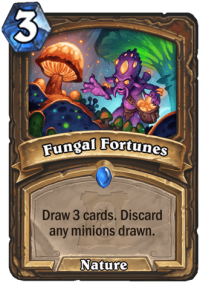
- Fungal Fortunes – It may seem counterintuitive to keep card draw against aggro opponents like Demon Hunter. However, drawing cards that early will reward you with more options to survive the problematic mid game, especially against Tempo Demon Hunter.
- Overgrowth – Similar to Fungal Fortunes, Overgrowth rewards greed. The sooner you reach turn 7 or 8, the better are your chances to lock out aggro decks.
- Wrath – While we want to mulligan aggressively for the two cards mentioned above, Wrath still provides just so much reliable removal against early aggro threats.
Lower Priority (keep only if certain conditions are met)
- Rising Winds – Rising Winds is a very interesting card in terms of mulligan strategy. Against aggro it provides much-needed board presence in the early game; that way you don’t have to spend one of your precious cheap spells to contest the enemy’s board.
- Glowfly Swarm – Keep it if you have some sort of removal in your hand already!
Vs Control Decks
Higher Priority (keep every time)
- Fungal Fortunes – Similar to aggro matchups, Fungal Fortunes moves you closer to answers needed against other control decks while providing more spells early to fuel your combo with.
- Overgrowth – An old Druid proverb reads as follows: “Against control, ramp is everything”. Overgrowth may be the most important mulligan card against control opponents.
- Glowfly Swarm – Makes an early win much more realistic, especially together with early board buffs!
Lower Priority (keep only if certain conditions are met)
- Overflow – Some pro players recommend keeping Overflow in every single mulligan. However, it can become quite clunky if you can’t ramp into it. You should always keep this when holding Overgrowth, and evaluate the given matchup and other cards shown in the mulligan based on your experience – it’s a 7-cost card, after all!
Spell Druid Play Strategy
General Strategy
While the content of this deck may seem outlandish in comparison to other Druid combo decks, the approach to Spell Druid’s win condition remains fairly simple: Survive the early and mid game while trying to draw into your combo pieces, and execute the combo to the best of your ability!
Pulling off a successful combo normally involves producing sturdy board states with almost no mana investment. But how do we get there? Before we can answer this question, we need to solve another dilemma first: Should we use combo pieces to make our main combo more reliable in the long run?

The cheap spell removal package involving Crystal Power, Wrath and Moonfire can be used to fuel the “1-2-free combo” as soon as Kael'thas Sunstrider hits the board. However, we have to accept the fact that early game threats need to be dealt with, and we can’t put eight copies of Wrath into our deck. The omnipresent Demon Hunter decks run more than enough 2-health minions so that Crystal Power provides excellent early board removal, and even Moonfire should be used to remove 1-health threats to use mana on more important things than a Hero power.
Another card that stores a dilemma in itself is Rising Winds. However, the outcome of this decision will be rewarding nonetheless. Against aggro opponents like Demon Hunter, Rising Winds can create early board presence that buys time and health points. It can also be used to create another token or draw an additional cheap spell over the course of one of our combos in the later stages of the game.
As you can see, there is no clear path in recommending when to use these spells – and that is where Druid’s new spell additions come into play.
In most Ashes of Outland card reviews, both Bogbeam and Ironbark were considered mediocre cards at best. However, the 7-mana restriction becomes much less painful when looking at Overgrowth – Druid’s new way of ramping up mana. Overgrowth enables Bogbeam and Ironbark much sooner – and brings Spell Druid in general much closer to executing its combo.
Besides that, Bogbeam can be used for early board removal as well – however, the 0-mana cost obviously plays a vital part in activating Kael’s and Mountseller’s abilities. The same goes for Ironbark – while it can provide a good portion of survivability in sticky situations, you should always keep in mind that a 0-mana spells work wonders when your combo enablers are on the board.
The same case can be made for Innervate. Ever since its inevitable nerf, this 0-mana spell should be used exclusively as part of a combo – exceptions may apply to this rule in sticky situations against aggro decks.
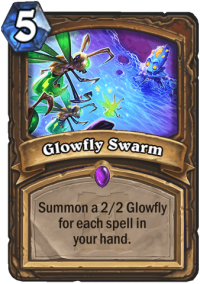
Now back to our first question: How does Spell Druid win games?
One of the main ways is to play a beautiful new card called Glowfly Swarm. What looks like a token dream come true creates a board full of 2/2’s for a mere 5 mana. And while we play a combo deck involving two minions, this spell which purely relies on other spells follows the law of simple Token Druid gameplay: The earlier you can create a wide board, the better are your chances of keeping it over one turn.
In the end Glowfly Swarm fulfills three purposes – it can create very early lethal board states, and it’s also a great tool to bait out expensive and suboptimal board clear. But first and foremost, it buys time – aggro opponents will hopefully be distracted from hitting our face, and control decks have to deal with this problematic board to execute their game plan as well.
Depending on the game state, turns 6 to 9 are where Spell Druid works its magic. If you have enough fuel and Kael’thas Sunstrider or Exotic Mountseller in hand, you should always try to make the most out of your situation. Holding one of your token creating spells is imperative as well.
If you’re still missing important pieces, you should get your backup plan going which is called Overflow. Inspired by everyone’s favorite Druid card Ultimate Infestation, Overflow can get you so much closer to the hand you want to empty on the next turn. It’s also one of two tools for healing; although it should almost never be used for that primarily.
While playing out Kael’s effect is pretty straight forward, Exotic Mountseller‘s effect includes a ton of randomness – and that makes this deck even more fun to play. A total of 15 3-mana beasts exist in the current Standard card pool, and the average stat outcome should be close to a 2.8/2.8 minion.
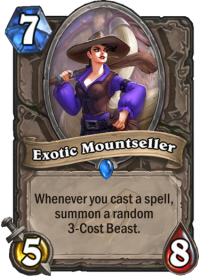
However, a good portion of these beasts have beneficial side effects: While Bad Luck Albatross pollutes Highlander decks, Zixor, Apex Predator and Diving Gryphon can provide additional on-the-spot board removal. The “nut draw” in this case though has to be Augmented Porcupine. This little fellow synergizes incredibly well with Spell Druid’s board buffs, and since Silence effects are much more rare thanks to Spellbreaker being out of Standard, its Deathrattle effect can destroy both the enemy’s board and health value.
But in the end, the effect “only” creates 3-mana beasts – this and the fact that we create 2/2 tokens most of the time requires us to have the best amount of information regarding our opponent’s strategy and board clearing capabilities.
Cards like Gift of the Wild and Power of the Wild help with making our boards more sturdy, and one copy of Soul of the Forest works wonders against repetitive board clear – but in the end, we need to accept the fact that Spell Druid has to play situations more than general matchups. For example, Galakrond Warlock may have more than enough board clear on paper – but if you were able to bait out early removal thanks to using Rising Winds, Power of the Wild and Glowfly Swarm, you can overextend with The Forest's Aid and your combo enabler.
Ultimately, Spell Druid follows a lot of Token Druid’s basic laws of gameplay, while relying on incredible Kael’thas mana-cheating turns – including building boards with The Forest's Aid and Glowfly Swarm, drawing through your entire deck with Overflow – or Exotic Mountseller boards full of angry porcupines and albatrosses.
Learn to master the multi-layered decision-making within Spell Druid’s toolkit, and you will have one of the most powerful and skill-intensive archetypes of the current meta at hand!
Vs Aggro Decks

Against aggro opponents, keeping early control of the board has to be your top priority. Yes, you will lose games by sacrificing spells to clear the board, but you’d lose even more if you kept them in your hand as combo pieces; you just can’t afford to ignore early threats like Battlefiend or Satyr Overseer.
Try to ramp up with Overgrowth while upping your board presence through Rising Winds or Power of the Wild early. Glowfly Swarm works wonders in terms of board control and can net you an early win here and there.
Besides your early removal answers, Ironbark is another key card in aggro matchups. Don’t be afraid to use it on one of your early tokens for value trading and additional defense.
However, you should never lose sight of your combo. Especially after playing Overgrowth, your late game will effect the board much sooner and eventually lock out most answers provided by Aggro decks.
Vs Control Decks
In control matchups, greed is the name of the game. Current control archetypes include Resurrect Priest or most Highlander decks, so Spell Druid players know when to expect certain power spikes like Dragonqueen Alexstrasza and Reno the Relicologist.
As already said, Overflow combined with Overgrowth are the top cards you are looking for to get ahead in the game. Combo decks thrive versus control opponents, and that goes for Spell Druid on multiple levels: First off, you can control the pace of the game by questioning your opponent’s ability to repeatedly clear the board. That again makes it harder for control archetypes to get on the board, because they will always try to deny lethal damage in favor of putting up their own threats; a well-timed Glowfly Swarm can already end the game.
Your highest priority should be to not overplay the board. Know when your opponent should have removal at hand on average, and play accordingly. Draw cards aggressively, but always keep in mind that Overflow should never overdraw any of your cards. If you can see your future endgame through your hand already, make sure to get hand space by playing Rising Winds or Power of the Wild early.
Spell Druid Tech Cards and Card Substitutions
- Force of Nature/Aeroponics/Garden Gnome/Anubisath Defender – The treant package is a valid choice depending on the fluctuating development of the current meta game. It sacrifices substantial removal and general spell availability for our two combo enablers while adding a good portion of token utility and board swing potential.
- BEEEES!!!/Starfall – In the light of Tempo Demon Hunter’s domination, players start to include more and more versatile board clear answers – and that can pay off big time, especially when comparing it to less influential spells likeMoonfire or Innervate
Leave a Reply
You must be logged in to post a comment.

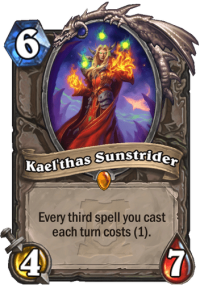


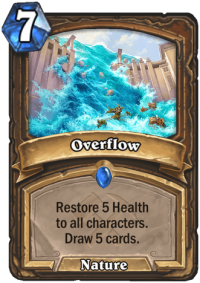
This deck like many other can really struggle against DH if you don’t have some early removal. I opted for 2x claw into the deck combined with 2x wrath, 2x bog and the 2x crystal power to help because if you only search for ramp, DH can shut you out of the game by turn 3-4 already.
I’ve seen those inclusions on ladder, and they can make sense against DH.
Don’t forget to watch the meta closely after the DH nerfs, though! 🙂